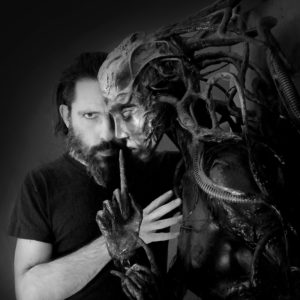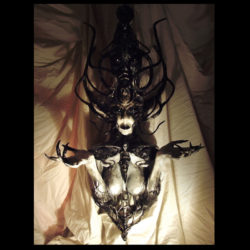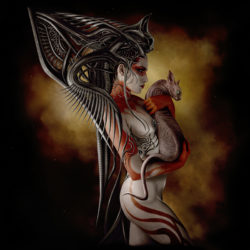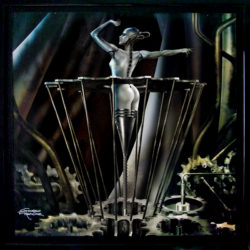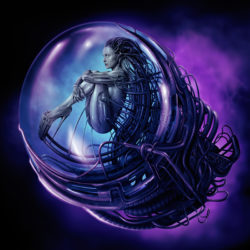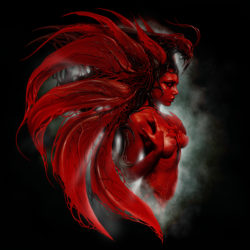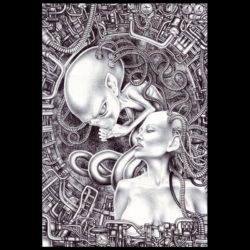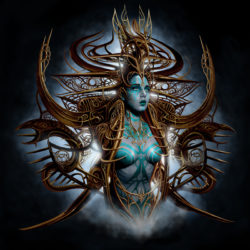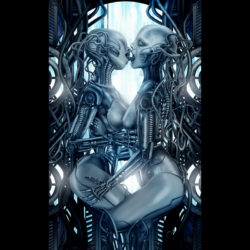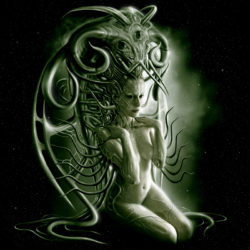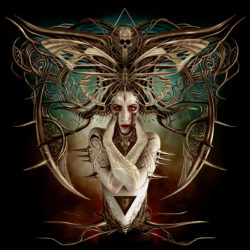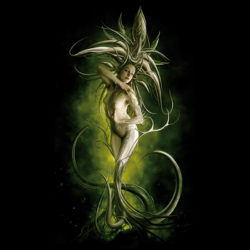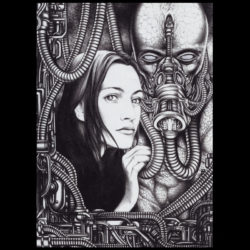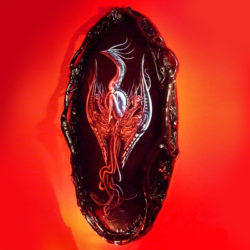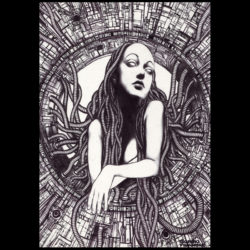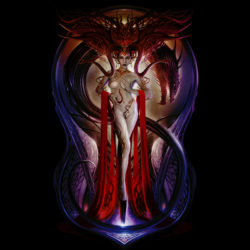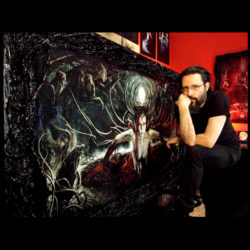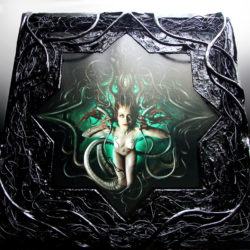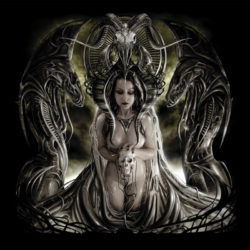Interview by Costanza Tagliaferri
Giorgio Finamore was born in Mestre, a small town nearby Venice in between its marvellous architecture and the cold darkness of an industrial area called Marghera. Growing up within this contradictory atmosphere, Giorgio explores the intricate relationship between body and machine; human and technology; reality and digital realm. Inspired by HR Giger, Gothic and science fiction, the artist combines diverse influences to explore multiple media and diverse content creating his own artistic world. The lens of technology becomes the point of contact between reality and imagination, creating futuristic characters belonging to parallel universes in between past and future; human and technology.
Playing with different styles and media, Giorgio looks at the present to create imaginary scenarios to think about possible futures and the controversy of our relationship with machines and digital realm.
Exploring the immense variety of his style and media, here is an interview to Giorgio about his art and inspiration.
Q: Between illustration and sculpture, graphic novel and digital media. How did you arrive to explore such diverse techniques?
A: Actually, I have been drawing since I was a child. I think I am a sort of experimental schizophrenic, which pushes me to adapt the forms of my drawings to diverse techniques. From my first black and white drawings with pen in the 90s, after two decades, my investigations evolved with time. Using technology, I explored new forms, colours and possibilities through digital painting, to then arrive at material experiments. I started late with sculpture (specifically working with clay and recycled material). At some point, I was just too curious to see the three-dimensional result of the visions I was projecting only in bi-dimensional form. Using diverse techniques, you can have different points of view still connected to each other.
Q: What of your personal research and what of your studies made you prefer the ‘Post-modern Gothic’?
A: I focus my work on this style because I have always been passionate in studying imaginary art, from Surrealism to the eighteenth-century Sublime; from Gothic to Horror; from cyberpunk to science fiction. I just melt together all this passion and obsessions in one unique though – in a personal style surely inspired by the Masters of the Past, but also very independent.
Q: How do you approach these kinds of contents in your art?
A: As I was saying, the idea is to melt different sources of inspiration to give form to a personal mental projection. Another very important theme, central to the evolution of my work, is how technology melts with the human body. For example, lately this kind of visionary metamorphosis is the result of a collaboration with different models; after taking a picture of them, I use digital painting to put their portrait into my scenic space, creating a fascinating relationship between reality and fantasy; life and dream.
Q: How much of your style is inspired by Hans Ruedi Giger?
A: In 2008, I had the great honour to personally meet Master HR Giger in his museum in Gruyères (Switzerland). I also had the incredible chance of showing him my artworks. Of course, I was following his work since I was very young. His disturbing and reactionary practice changed the history of art, influencing several artists from my generation, not only working with Bio-mechanic art. I could talk for hours about his marvellous and inspiring artworks, but as an artist, when you sit on the working table you have to find your own way. With my style and creations, I always try to not have too specific reference to artists or movement, because for me the real challenge is to create your own imaginary world.
Q: You also illustrate books in collaboration with other authors. How working with words is influencing your forms and characters?
A: Surely! The illustration works coming from written tales are a different kind of work comparing to the free vision that I can express without words. When I am working with someone else’s storyline, it is hard to keep control on any detail, and my stylistic world comes across almost as a limitation. These restrictions are influencing the different elements of scenarios and characters, as well as some technical direction typical of the illustration world – I won’t go in detail with this explanation!
Q: You published the illustrated book ‘Biomechanical Circus’ with Logos Publishing House in 2012. How telling a story only with images has challenged your style?
A: I think of ‘Biomechanical Circus’ as a ‘silent movie’. I was telling a story without words, only with a short caption to introduce the viewer into this imaginary circus of biomechanics freaks. The project is really close to the notion of ‘art book’. And, I would dare to say that it is not a challenge because, indeed, you are free of creating atmospheres without the limitation of a pre-set story. Without the filters of writing, the images can have an immediate impact on the mind of the viewer.
Q: Though different media your works explore the intricate relationship between art and technology, men and machine. How much comes from fiction and how much from your vision of society?
A: The visionary lens of imagination filters everything. My starting point, however, is a reflection on society; on human beings; on alienation; the places of life and metropolis; fast industrialization. These themes were already at the core of the Expressionism movement, and I found scary that this discourse still applies to our society, after a siècle. Crucial for me was my hometown, nearby Venice but also connected to an industrial area called Marghera. Crossing the bridge to Venice, you have to pass through this industrial area. It feels like passing through a dark, techno-industrial nightmare to arrive to Venice’s bright decorations. This architectural contradiction has always been influencing my vision and my art.
Q: Inspired by horror and science fiction, your work often portraits the most dramatic turn of the influences of technology in our life. How do you see the evolution of this relationship in the future?
A: I think I have passed through diverse stages of this theme. Or maybe, I am still in the middle of something difficult to define. At the beginning, I was interested in exploring the deepest darkness of this theme, and I had the claustrophobic tendency to fill up any empty space in the canvas. Lately, I give more value to the empty spaces to expand my notion of body’s representation and light. Probably, the evolution of my style goes together with the technological development of the last years. These developments manifest in different forms comparing to twenty years ago but, in substance, we are still trapped in the same schema: machines are built to help man, and man use technology to expand the human control on things – even though, the risk of loosing control is increasing every day more.
Q: Your work often transforms the human body with machinery or alien mutations. How do you imagine the human population in the future?
A: It is difficult to imagine. My visions are atemporal and, honestly, I still need to understand if they belong to the future, to the past, or to a retro-future. Doubtless, the present inspires most of my reflection on how the future population will look like tomorrow. The core theme of my work is the mutual relationship between body and machine pushing the limits of different scenarios and cybernetic hybrids. We are living in a world controlled by machines and computer, which are now almost under our skin… it looks like science fiction, but this ‘future’ is already present.
Q: Could you tell us your future projects and collaborations?
A: I am always quite secretive when I have to talk about future projects – at least until they are not on the run! Anyway, I am collaborating both as a graphic and as an illustrator with different musician, writers, publishing houses. I am mainly working with Weird Book publishing house, for which I am realising the illustration for Joe Lansdale’s book. There are different open projects very interesting; and, least but not last, I would like to collect all my artistic works from the past twenty years in a book on Post-modern Gothic.



